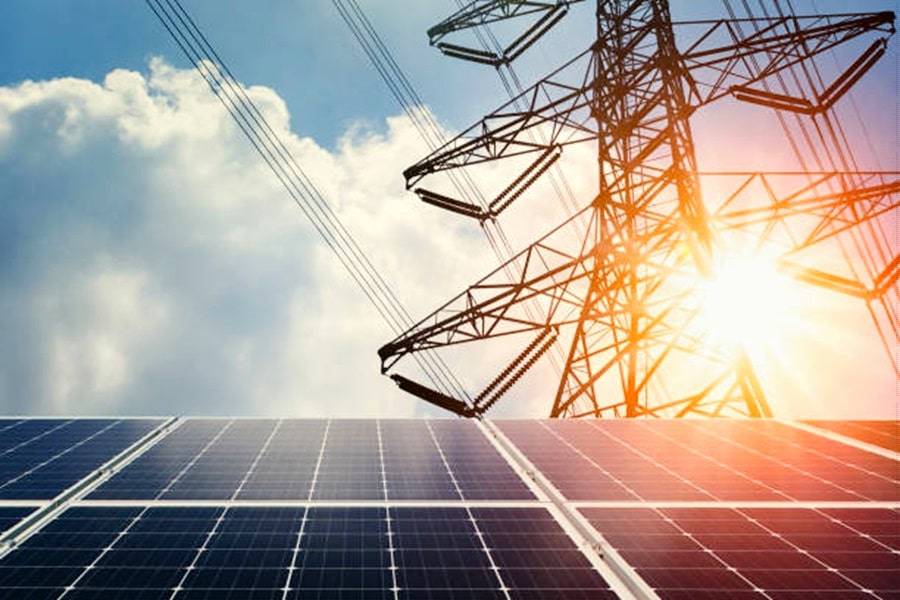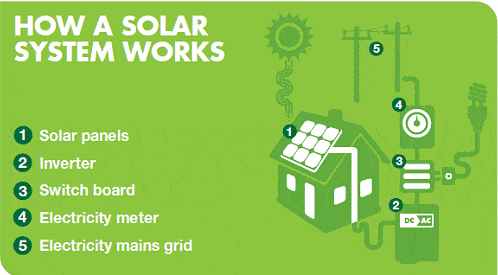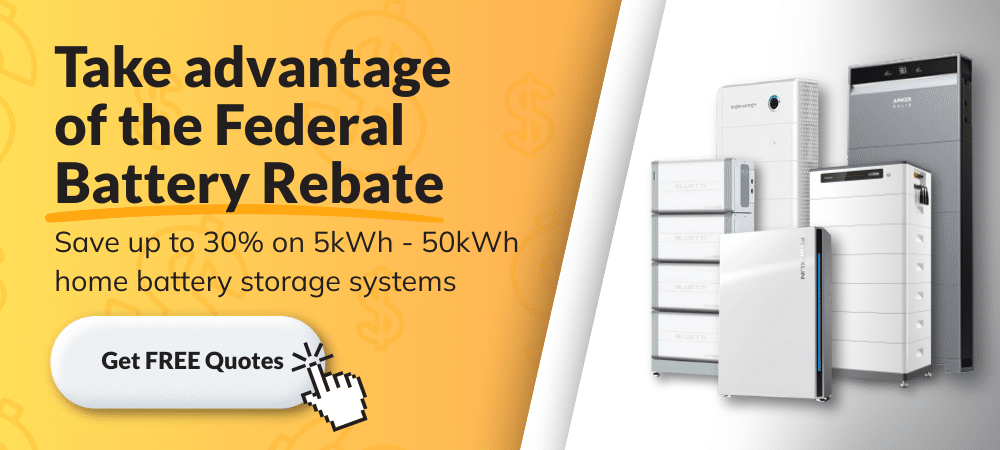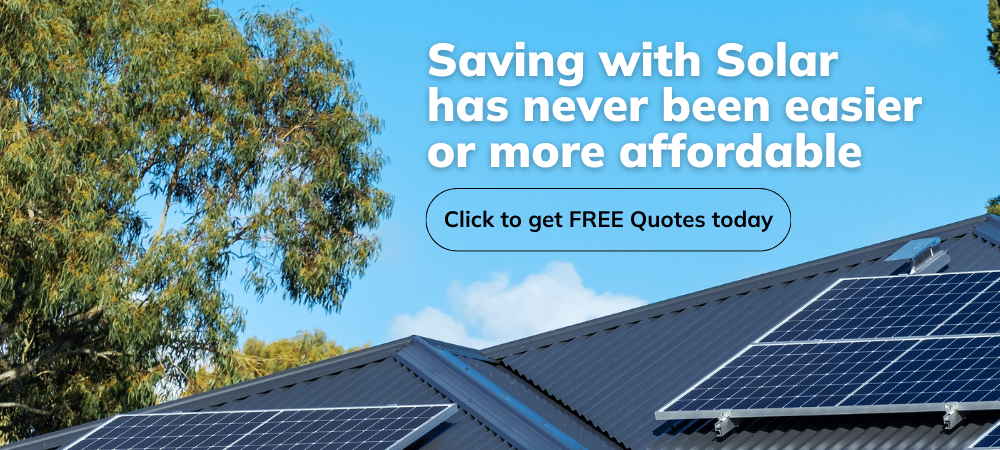While the technology behind solar energy seems complex, when broken down, how solar power works is easy to understand. This is particularly so with grid connect systems as they require few components installed in your home or business.
To shed light on your solar journey, consider getting FREE solar quotes from Energy Matters. Our expertise extends beyond mere sales pitches, offering a wealth of information to guide you through the process. By taking this step, you empower yourself to make decisions about integrating solar technology seamlessly into your daily life.

On this page
How do solar panels work?
Solar panels are fascinating pieces of technology that harness the sun’s energy to generate electricity. They consist of multiple photovoltaic (PV) cells, usually made of silicon, that convert sunlight into direct current (DC) electricity. When sunlight hits the PV cells, it excites the electrons in the silicon atoms, causing them to flow and create an electric current. This current is captured by wiring within the panel and directed to an inverter, which transforms the DC electricity into alternating current (AC) electricity—the type used in homes and businesses. Excess electricity can be stored in batteries or fed back into the grid for later use, providing a clean, renewable source of power. Solar panels are not only an environmentally friendly option but can also lead to significant savings on energy bills.
Components of a solar electric system
To understand fully how does solar works, it is crucial to understand the key components of a solar electric system. Solar panels, the heart of any solar grid-connected system, contain photovoltaic (PV) cells. These cells convert sunlight into direct current (DC) electricity. An inverter transforms this DC electricity into alternating current (AC) electricity, which is compatible with your home’s electrical system and the solar grid.

- The sun shines on the solar panels generating DC electricity
- The DC electricity is fed into a solar inverter that converts it to 240V 50Hz AC electricity.
- The 240V AC electricity is used to power appliances in your home.
- Your electricity meter records and measures your solar production and consumption.
- Surplus electricity is fed back into the main grid.
Energy Matters has been a leader in the renewable energy industry since 2005 and has helped over 40,000 Australian households in their journey to energy independence.
Let us discuss and choose the best quote that suits your needs and budget, and we can connect you with our trusted local installers, who will provide up to 3 FREE solar quotes for your home and business solar energy system.
How does the sun give solar energy?
There are two main types of solar energy technologies: solar thermal and solar photovoltaic (PV). Solar thermal systems use the sun’s heat to heat water or air, which can then be used for space heating, hot water, or industrial processes. Solar PV systems convert sunlight directly into electricity.
Solar energy is generated when the sun’s photons strike a solar panel. The solar cells in the panel absorb the photons, which create an electric current. This current can then be used to power homes, businesses, and other devices.
Whenever sunlight shines on solar cells (and even in overcast weather), it causes the electrons to release from their place, leaving a hole in which another electron can fall and interact with it to generate energy. We describe the movement of the electron as electricity. This occurrence is the Photovoltaic Effect, which is referred to as PV.
The solar inverter converts the DC electricity produced by the solar panels into 240V AC electricity, which can then be used by the property/household, exported to the grid, or stored in a battery storage system.

If a grid connects system is producing more power than the home consumes, the surplus is fed into the power grid. Some electricity companies meter the electricity fed into the grid by your system and provide a credit on your bill. How much you are paid is determined by the feed-in tariff.
When the solar cells are not producing power, for example at night, power comes from the mains power grid as usual. The energy retailer charges the usual rate for the power used.
As all components in a system have no moving parts, you can expect a long, hassle-free life from your solar power system! Generous government solar rebates and incentives mean you can also save thousands on a grid-connect system.
Take advantage of solar hot water rebates
Government incentives can make investing in solar electric systems or hot water even more affordable. Homeowners can access solar hot water rebates that help offset installation costs, making sustainable energy solutions more accessible. These rebates vary by state and can offer significant financial savings for those transitioning to solar-powered water heating.
What is an on-grid solar power system?
An on-grid system is a solar PV system that is connected to the local electricity grid. Unlike an off-grid system, your home is able to draw electricity from the grid at times when your home is unable to draw electricity from your solar system. This is most common at night, during cloudy whether, or when your home is using more electricity than your solar system is producing.
There are many benefits of a grid-connected system. Any excess electricity created by your solar system can be exported to the grid (or a battery, should you have one installed). You will receive a feed-in tariff when you export to the grid which will result in a credit on your eletricity bill. You should see a significant reduction in your electricity bills due to the feed-in tariff and the reduced reliance on the grid due to the use of your solar system.
A grid-connected system will also ensure you always have the energy you need to power your home, save for blackout events.
A grid-connected system is also cheaper to purchase, install, and maintain than an off-grid system.
Power vs Energy
Power and Energy are two different functions. Most people interchange these two important terms in the industry.
Electrons in a wire generate electrical current, and the speed at which they are moving indicates the current’s power. So Power refers to the speed at which electricity is generated or used. The basic units of Power are joules per second and measured in kilowatt (kW). A solar system’s peak kilowatt output determines its size.
Watts = Joules per second = Rate of energy use
An energy unit is a kilowatt hour (kWh) and not power. Energy is the amount of electricity stored, generated, or used during a time. For instance, today my solar PV system generated 16 kilowatt hours of electricity, my battery stores 13 kWh of energy, or my heater used 4 kilowatt hours of energy today.
Installing a grid connect solar power system
Most customers choose a roof-mounted solar power system. For most of Australia, panel installation facing north is preferred to take full advantage of the sun. However, east or west-facing installation may also be desirable or better placed if there’s a lot of shade on the north-facing part of your roof. This positioning may provide power at the time of the day when there is most demand.
Your solar installer will aim to install the modules at an angle that ensures that the glass face of the modules is positioned at 90 degrees to the sun for most of the day.
As an example, in Sydney, this angle would be approximately 30-40 degrees to the horizontal. Standard Australian roofs usually have an angle of elevation of ~22 degrees, which is acceptable. This provides a close approximation to the position in which a solar array produces its maximum output. For installations on flat roofs, an elevated array frame allows the installation of the solar modules at an angle of elevation of approximately 30 degrees from the horizontal.
What’s the right size solar power system? How much will it cost?
Everyone’s needs are different and the generation potential of solar power differs from place to place. To help, we provide a quick way to get an answer to both these questions. Use our free solar quote to get up to 3 free solar quotes from our network of trusted, local installers. You can also learn more about solar power system sizing here.
How is solar energy stored?
Solar energy is stored in Australia in a variety of ways, including:
- Solar batteries: Solar batteries are Australia’s most common way to store solar energy. They can be used to store energy from solar panels at night or on cloudy days.
- Thermal energy storage: Thermal energy storage systems use the heat generated by solar panels to heat a liquid or solid material. This heat can then be used to generate electricity or provide hot water.
- Pumped hydro: Pumped hydro is a large-scale energy storage system that uses the potential energy of water to store energy. When there is excess solar energy, water is pumped to a reservoir at a higher elevation. When energy is needed, the water is released back to the lower reservoir, turning a turbine to generate electricity.
- Compressed air energy storage: Compressed air energy storage (CAES) is a large-scale energy storage system that compresses energy. When there is excess solar energy, the air is compressed and stored in an underground cavern. When energy is needed, the air is released and expanded through a turbine to generate electricity.
The choice of storage technology depends on a number of factors, including the size of the solar system, the cost of the technology, and the local climate. Batteries are the most common choice for residential solar systems, while thermal energy storage, pumped hydro, and CAES are more common for large-scale solar systems.
In Australia, batteries are the most common way to store solar energy for residential and commercial use. This is because they are relatively affordable and easy to install. Batteries can also provide backup power in the event of a power outage.
For large-scale solar farms, thermal energy storage and pumped hydro are more common options. These technologies are more expensive than batteries but can store much more energy. This makes them ideal for solar farms that need to store energy for long periods of time. Learn more: Can You Store Solar Energy?
As the cost of solar energy storage continues to fall, it is likely that we will see more widespread adoption of these technologies in Australia. This will help make solar energy a more reliable and affordable power source.
Embrace the energy efficiency revolution by upgrading your solar systems and adding a battery or solar inverters with Energy Matters.
With our 3 free solar quotes, you can compare plans from pre-qualified and vetted installers in your area and find the perfect solution for your home and business. Harness the sun’s power and save money on electricity bills while reducing environmental impact. Let Energy Matters guide you towards a brighter, more sustainable future.
How is solar power impacting all economies globally today?
Solar power is having a major impact on economies globally and in Australia. The cost of solar panels has fallen dramatically in recent years, making solar power more affordable for businesses and households. This has led to a surge in solar installations, which is helping to reduce reliance on fossil fuels and lower energy costs.
In Australia, solar power is now the fastest growing source of new electricity generation. In 2022, solar power accounted for 11% of Australia’s electricity generation, which is expected to continue to grow in the coming years. The growth of solar power is having a number of positive economic impacts in Australia.
- Lower energy costs: Solar power can help businesses and households to reduce their energy bills. This can save businesses money, which can be reinvested in other areas of the economy. It can also help households to save money, which can be used to purchase other goods and services.
- Job creation: The solar industry is a major source of employment in Australia. In 2022, the solar industry employed over 60,000 people. This figure is expected to grow in the coming years as the demand for solar power increases.
- Export opportunities: Australia is a leading exporter of solar panels and other solar equipment. The growth of the solar industry is creating export opportunities for Australian businesses.
- Reduced greenhouse gas emissions: Solar power is a clean energy source that does not produce greenhouse gas emissions. This is helping to reduce Australia’s carbon footprint and combat climate change.
Tired of being the last to know about updates in the renewable energy world? Missed out on a state rebate or incentive? Looking to find out more about how you can save on your utility bills? Subscribe to Energy Matters’ weekly newsletter and keep updated with Australian and international news, incentives, and offers.
What does the future hold for solar energy?
The future of solar energy in Australia is bright. The country has some of the best solar resources in the world, and the government is committed to increasing the use of renewable energy. In 2022, solar photovoltaic (PV) systems accounted for 38.3% of Australia’s total renewable generation technology type. This number is expected to grow rapidly in the coming years, with the Australian Energy Market Operator (AEMO) forecasting that solar PV system capacity will grow from 11.1 GW in 2019 to 22 GW and 50 GW by 2040.
There are a number of factors that are driving the growth of solar energy in Australia. These include:
- Government policies: The Australian government has a number of policies in place that are designed to promote the use of renewable energy, including the Renewable Energy Target (RET) and the Small-scale Renewable Energy Scheme (SRES). These policies have made solar PV systems more affordable and accessible to Australian households and businesses.
- Technological advances: Solar PV technology has been improving rapidly in recent years, making it more efficient and affordable. This has made solar PV systems a more attractive option for consumers.
- Rising demand for renewable energy: There is a growing demand for renewable energy in Australia as consumers and businesses look for ways to reduce their reliance on fossil fuels. Solar PV is a clean, affordable, and reliable renewable energy source well-suited to the Australian climate.
In addition to the factors mentioned above, several other trends are expected to further boost the growth of solar energy in Australia in the coming years. These include:
- The growth of the electric vehicle market: Electric vehicles require significant energy, and solar can be used to power them.
- The development of battery storage technology: Battery storage technology is becoming more affordable and efficient, allowing solar energy to power homes and businesses even when the sun is not shining.
- Beyond generating electricity:
- Solar energy can efficiently heat water. A solar hot water system uses solar collectors to capture sunlight and warm water for household needs, significantly reducing dependence on conventional energy sources. By switching to solar hot water, homeowners can lower their energy bills and reduce their carbon footprint while ensuring a reliable hot water supply.
- Solar heat pumps provide an innovative solution for homes looking to enhance energy efficiency. These systems capture heat from the surrounding air and solar energy to efficiently warm water—even in cooler climates. Solar heat pumps consume less electricity than traditional water heaters, making them a cost-effective and environmentally friendly choice.
- The increasing awareness of climate change: Australians are becoming more aware of the need to reduce their carbon emissions, and solar is a great way to do this.
All these trends point to a bright future for solar energy in Australia. The country is well-positioned to become a major global leader in producing and using solar energy.









































